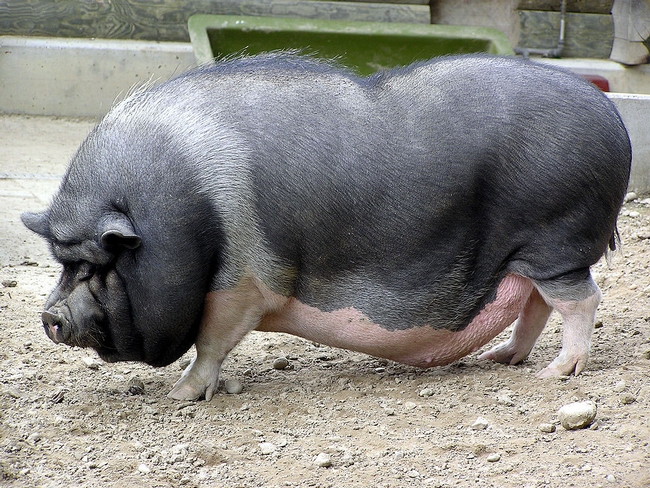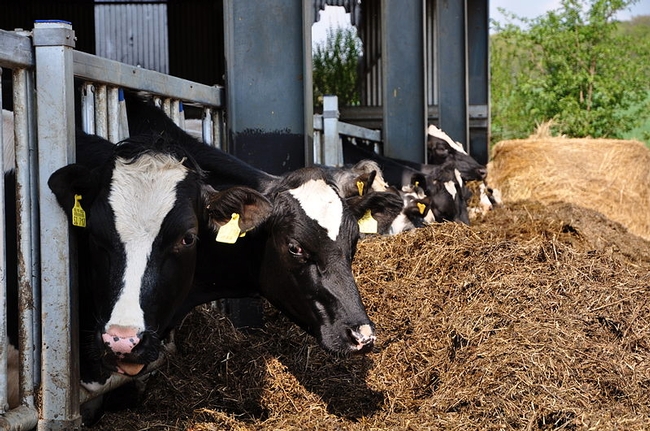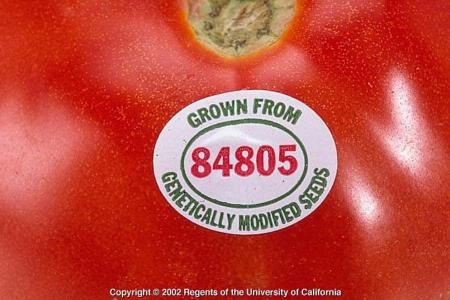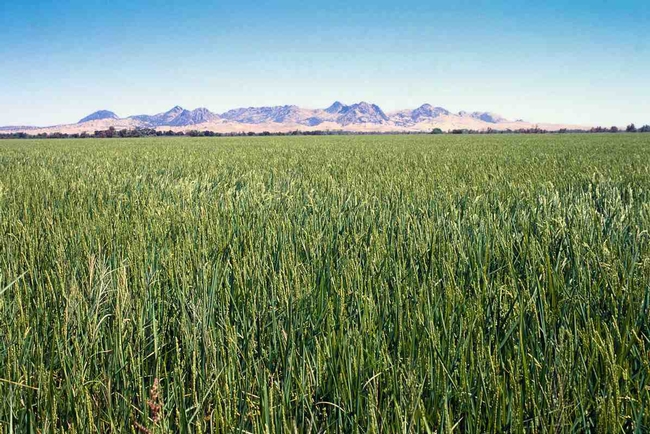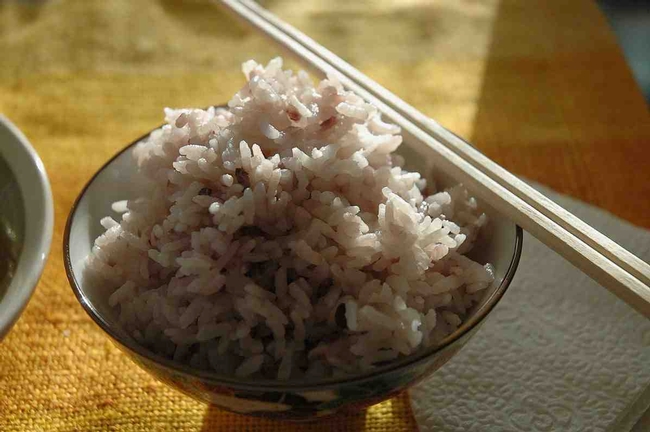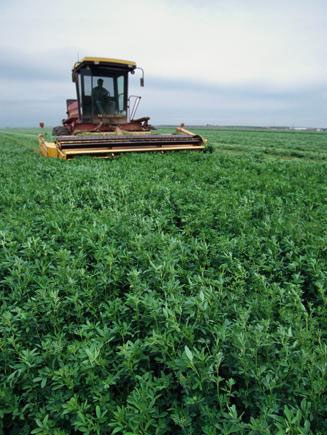Posts Tagged: genetically modified organism
Chinese scientists use biotechnology to develop tiny pig pets
In the story, a UC Agriculture and Natural Resources expert expressed disappointment in the company's plan to market mini pigs as pets. Alison Van Eenennaam, UC ANR Cooperative Extension specialist in the Department of Animal Science at UC Davis, said the company's decision reflects the "global regulatory gridlock" around genetically engineered food animals.
"Genome editing is a powerful technology that can be used for many beneficial applications … such as producing disease-resistant animals and other things that would have real benefits for the sustainability of food production," she said.
Americans seem to be open to genetically engineered pets. A glowing fish created in Singapore by inserting jellyfish and sea anemone genes into zebrafish eggs has been accepted by many U.S. consumers.
"People are happy to have them in their aquarium, but it's when it's on their dinner plat that they have a different attitude," Van Eenennaam said.
Scientists used different processes in creating glowing fish and miniature swine. With the fish, genes from other organisms were inserted into the DNA. The mini pigs were made by cutting tidbits of DNA out of the pig genome. According to the article, Van Eenennaam believes gene editing animals is no different from traditional selective breeding. Furthermore, she said the FDA's unwillingness to approved genetically engineered food animals is impeding the technology. Companies are deterred from investing in research by the uncertainty.
"(There's too much financial risk) if you go to all the effort of making an animal and it's unclear whether you're going to be able to market it," Van Eenennaam said.
Humboldt County voters to weigh in on GMOs
Alison Van Eenennaam, UCCE specialist in the Department of Animal Science at UC Davis, said there are thousands of scientific studies that have shown that GMOs are not dangerous. Van Eenannaam herself published a review in September that examined 30 years of livestock-feeding studies that represent more than 100 billion animals. She concluded that the performance and health of food-producing animals consuming genetically engineered feed has been comparable to that of animals consuming non-GE feed.
Van Eenennaam cautioned the North Coast Journal reporter that "you can't just say 'GE is safe.'"
"That's too broad," she said. "That's like saying 'electricity is safe.' People who've been in the electric chair would disagree."
One can't say that traditional breeding is "safe," either. People have been breeding organisms to select for specific traits, and creating hybrids by crossing two species (such as a horse and donkey to get a mule) for thousands of years, the article said.
In San Luis Obispo County, where a measure banning GMOs failed in 2004, organic farmers are using buffers and communication with neighbors to allow farmers who use GMOs to coexist with non-GMO farmers.
"Coexistence is not a new idea,"said Mary Bianchi, director of SLO County UCCE. But it's been working. And, she says, nobody has pushed for a GMO-ban in San Luis Obispo County since.
The director of UC Cooperative Extension in Humboldt County, Yana Valachovic, said she and her office haven't taken a side in the debate over the Humboldt County measure.
She said she believes the issue boils down to one question: "Are we more concerned about the risks or more hopeful of the opportunities?"
Unfounded fear of GMOs keeps good food out of the marketplace
Food created through genetic engineering and conventional breeding are safe and they deserve equal treatment in the marketplace, a UC Berkeley biotechnology expert told reporter Lisa Krieger of the San Jose Mercury News.
Peggy G. Lemaux, UC Cooperative Extension specialist in the Department Plant and Microbial Biology at UC Berkeley, says fear of the unknown can stop genetic engineering from helping consumers. She genetically engineered wheat to produce grain that is less allergenic and might be better tolerated by people with wheat allergies. Because of anti-genetic-engineering sentiment, she said, companies that could take it to market did not embrace it.
"No one is interested in moving it to the marketplace," Lemaux said.
The Mercury News article was centered on Proposition 37, an initiative on California's November ballot that, if passed, will require labeling on genetically engineered food.
Transgenic rice? Not any time soon
Although 10 years have passed since the first regulatory approval of genetically engineered, herbicide-tolerant rice, no transgenic rice is grown commercially, either in California or nationwide.
In contrast, genetically modified crops such as soy, corn and cotton have received widespread adoption by U.S. farmers.
Debate continues over whether genetically modified rice would be a plus or minus for the environment. While herbicide-tolerant varieties could reduce herbicide applications overall — they could also contribute to herbicide resistance in weedy rice.
For the time being, however, market considerations have trumped the debate over environmental costs and benefits.
A recent article in California Agriculture featured a literature review and extensive interviews with California rice growers explaining why.
“Although several studies suggest that transgenic rice would benefit California rice growers — particularly the herbicide-tolerant varieties — transgenic rice also presents economic risks,” writes Dustin Mulvaney, lead author, and now assistant professor at San Jose State University.
For one, California growers rely on exports for half of their sales. At present, Japan alone constitutes 41 percent of the state’s export market. Japan purchased more than $421 million in 2009 — over 40 percent of the industry's exports.
Japan has suggested that if tests on imports reveal transgenic traits, it would deny rice shipments. Other international customers such as Taiwan, Turkey and South Korea have followed suit. Both Taiwan and South Korea have asserted strict import restrictions on transgenic rice. Turkey banned transgenic rice altogether.
“While it is difficult to determine whether protectionism, culture or biosafety are the main forces driving such policies, all play a role in discouraging the deployment of transgenic rice,” Mulvaney said
California growers manage risks to marketability through the California Rice Certification Act. The act targets “characteristics of commercial impact,” including those of transgenic rice. The act states that growers rely upon identity preservation in the “production, handling and marketing practices that maintain the integrity and purity of agricultural commodities.”
Identity preservation is used to manage “genetic pollution” risks from transgenic crops (California Agriculture July-September 2006), particularly those not approved for human consumption or used to make pharmaceuticals (California Agriculture April-June 2007). In these latter cases, identity preservation must be 100% effective.
Mulvaney notes, “The commercial approval of transgenic rice in California is unlikely until there is widespread market acceptance and growers are assured of no sales interruptions. “
Can GE and non-GE alfalfas co-exist?
Those of us who work with alfalfa have seen our much-loved Queen of Forages relegated to poster child of all things evil about genetic engineering (GE) and the supposed damage it may wreak. While hay growers have always felt alfalfa has received insufficient attention – this was probably not what they had in mind!
I’m referring, of course, to the release of Roundup Ready alfalfa (RRA) in 2005 and the subsequent lawsuit that stopped its planting from 2007 until 2011 – a case that went all the way to the Supreme Court!
The drama continues today with newly minted lawsuits, as farmers once again plant RRA and conventional alfalfa throughout the U.S. But what does this ballyhoo mean for those who actually grow alfalfa?
At the heart of the controversy is co-existence: whether cross-pollination from GE alfalfa would completely prevent organic or other growers who didn’t want GE alfalfa from practicing agriculture as they see fit. Or, alternatively, whether farmers can adopt methods to avoid undue neighbor influence or contamination.
Successful coexistence can be defined as the ability of diverse production systems (organic, GE-adopting, conventional) to thrive without excessive neighbor influence, or resorting to extraordinary protection measures.
Is co-existence possible? The answer is a definitive “yes” based on both history and principle. Agriculture is replete with examples of farmers adjusting and cooperating to make diverse systems work. In principle, there is no technical reason that diverse farming practices cannot co-exist.
So if you produce alfalfa for organic, export or other markets that don’t want GE crops, what is required? The answer is very different for those who grow alfalfa for hay vs. those who produce seed. Seed requires considerable isolation distances to prevent contamination – and always has.
For hay, a series of steps can reduce this risk to very low levels.
The first, and most important step is to plant seed tested and determined as non-GE. Plenty of conventional seed is available, as are inexpensive testing methods to assure that the seed is non-GE. Seed companies have committed to produce conventional seed in the future, including seed destined for GE-sensitive markets.
The next step is to assure that contamination doesn’t happen during harvest – through partial bales moving in balers from field to field or accidental misidentification of hay lots. This is likely the second-highest risk of contamination.
The lowest – but not zero – risk of contamination in hay: inadvertent gene flow from hayfield to hayfield.
Neighbors can reduce this risk further by: 1) Controlling unharvested plants on field edges and feral alfalfa along roadsides to prevent seed production; 2) Routinely harvesting hay to prevent excessive flowering; and 3) Completely removing crop before excessive flowering or seed production. Crop removal prevents permanent contamination, since seed must fall to the ground and grow into new plants to contaminate hayfields.
Lastly, it is important to understand thresholds or market tolerance.
Does a single RRA stem, accidently baled in a 200-ton lot of conventional hay (containing billions of stems), constitute contamination? This will be market-determined. Commercially available test strips will likely satisfy most if not all sensitive markets of a hay product’s non-GE status. All markets have thresholds for contaminants, and there is no reason to believe this to be an exception.
In short, methods are readily available to assure an alfalfa crop’s non-GE status, even as neighbors start growing GE alfalfa. These require a higher awareness of gene flow and other avenues of contamination, but do not appear to be onerous or difficult.
We also should not underestimate the importance of mutual respect and willingness to cooperate among parties as keys to a co-existence strategy. It is axiomatic that coexistence is impossible if parties are unwilling to listen to each other, allow a diversity of viewpoints or develop a way to resolve disputes.
The alfalfa industry has largely stepped forward to support diverse systems within the agricultural landscape and needs to continue to do so. This has been the case with National Alfalfa & Forage Alliance efforts to promote coexistence over the past 5 years, which continue today (see their website). Seed companies and growers continue to negotiate isolation distances for production of GE and non-GE seed. Likewise, hay farmers have demonstrated co-existence by growing RRA and organic alfalfa successfully on the same farms.
This year in California’s Imperial Valley, seed, hay and organic growers, exporters and seed companies have met extensively and decided to prohibit RRA in their region due to the close proximity of seed, hay, biological factors and the importance of seed and hay exports.
These are examples of “bottom-up” co-existence approaches led largely by farmers and companies – in contrast to regulations decided in Washington or through the courts.
The concept of right-to-farm and co-existence between neighbors and diverse industries is not new to agriculture. Yet the introduction of GE alfalfa and its potential influence on neighboring farmers requires improved co-existence strategies for alfalfa.
(This article was first printed in Hay and Forage Grower magazine.)


